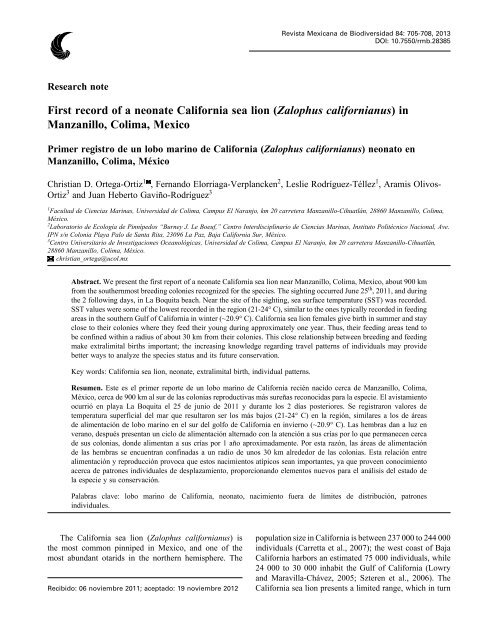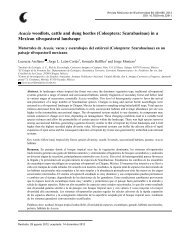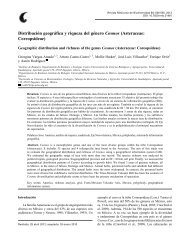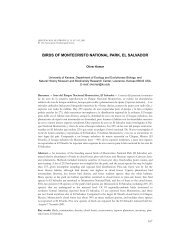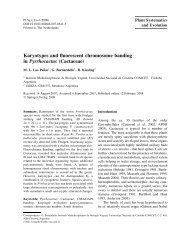First record of a neonate California sea lion (Zalophus californianus ...
First record of a neonate California sea lion (Zalophus californianus ...
First record of a neonate California sea lion (Zalophus californianus ...
- No tags were found...
Create successful ePaper yourself
Turn your PDF publications into a flip-book with our unique Google optimized e-Paper software.
Revista Mexicana de Biodiversidad 84: 705-708, 2013Revista Mexicana de Biodiversidad 84: 705-708, 2013DOI: 10.7550/rmb.28385 DOI: 10.7550/rmb.28385 705Re<strong>sea</strong>rch note<strong>First</strong> <strong>record</strong> <strong>of</strong> a <strong>neonate</strong> <strong>California</strong> <strong>sea</strong> <strong>lion</strong> (<strong>Zalophus</strong> <strong>californianus</strong>) inManzanillo, Colima, MexicoPrimer registro de un lobo marino de <strong>California</strong> (<strong>Zalophus</strong> <strong>californianus</strong>) neonato enManzanillo, Colima, MéxicoChristian D. Ortega-Ortiz 1 , Fernando Elorriaga-Verplancken 2 , Leslie Rodríguez-Téllez 1 , Aramis Olivos-Ortiz 3 and Juan Heberto Gaviño-Rodríguez 31 Facultad de Ciencias Marinas, Universidad de Colima, Campus El Naranjo, km 20 carretera Manzanillo-Cihuatlán, 28860 Manzanillo, Colima,México.2 Laboratorio de Ecología de Pinnípedos “Burney J. Le Boeuf,” Centro Interdisciplinario de Ciencias Marinas, Instituto Politécnico Nacional, Ave.IPN s/n Colonia Playa Palo de Santa Rita, 23096 La Paz, Baja <strong>California</strong> Sur, México.3 Centro Universitario de Investigaciones Oceanológicas, Universidad de Colima, Campus El Naranjo, km 20 carretera Manzanillo-Cihuatlán,28860 Manzanillo, Colima, México.christian_ortega@ucol.mxAbstract. We present the first report <strong>of</strong> a <strong>neonate</strong> <strong>California</strong> <strong>sea</strong> <strong>lion</strong> near Manzanillo, Colima, Mexico, about 900 kmfrom the southernmost breeding colonies recognized for the species. The sighting occurred June 25 th , 2011, and duringthe 2 following days, in La Boquita beach. Near the site <strong>of</strong> the sighting, <strong>sea</strong> surface temperature (SST) was <strong>record</strong>ed.SST values were some <strong>of</strong> the lowest <strong>record</strong>ed in the region (21-24° C), similar to the ones typically <strong>record</strong>ed in feedingareas in the southern Gulf <strong>of</strong> <strong>California</strong> in winter (~20.9° C). <strong>California</strong> <strong>sea</strong> <strong>lion</strong> females give birth in summer and stayclose to their colonies where they feed their young during approximately one year. Thus, their feeding areas tend tobe confined within a radius <strong>of</strong> about 30 km from their colonies. This close relationship between breeding and feedingmake extralimital births important; the increasing knowledge regarding travel patterns <strong>of</strong> individuals may providebetter ways to analyze the species status and its future conservation.Key words: <strong>California</strong> <strong>sea</strong> <strong>lion</strong>, <strong>neonate</strong>, extralimital birth, individual patterns.Resumen. Este es el primer reporte de un lobo marino de <strong>California</strong> recién nacido cerca de Manzanillo, Colima,México, cerca de 900 km al sur de las colonias reproductivas más sureñas reconocidas para la especie. El avistamientoocurrió en playa La Boquita el 25 de junio de 2011 y durante los 2 días posteriores. Se registraron valores detemperatura superficial del mar que resultaron ser los más bajos (21-24° C) en la región, similares a los de áreasde alimentación de lobo marino en el sur del golfo de <strong>California</strong> en invierno (~20.9° C). Las hembras dan a luz enverano, después presentan un ciclo de alimentación alternado con la atención a sus crías por lo que permanecen cercade sus colonias, donde alimentan a sus crías por 1 año aproximadamente. Por esta razón, las áreas de alimentaciónde las hembras se encuentran confinadas a un radio de unos 30 km alrededor de las colonias. Esta relación entrealimentación y reproducción provoca que estos nacimientos atípicos <strong>sea</strong>n importantes, ya que proveen conocimientoacerca de patrones individuales de desplazamiento, proporcionando elementos nuevos para el análisis del estado dela especie y su conservación.Palabras clave: lobo marino de <strong>California</strong>, neonato, nacimiento fuera de límites de distribución, patronesindividuales.The <strong>California</strong> <strong>sea</strong> <strong>lion</strong> (<strong>Zalophus</strong> <strong>californianus</strong>) isthe most common pinniped in Mexico, and one <strong>of</strong> themost abundant otarids in the northern hemisphere. TheRecibido: 06 noviembre 2011; aceptado: 19 noviembre 2012population size in <strong>California</strong> is between 237 000 to 244 000individuals (Carretta et al., 2007); the west coast <strong>of</strong> Baja<strong>California</strong> harbors an estimated 75 000 individuals, while24 000 to 30 000 inhabit the Gulf <strong>of</strong> <strong>California</strong> (Lowryand Maravilla-Chávez, 2005; Szteren et al., 2006). The<strong>California</strong> <strong>sea</strong> <strong>lion</strong> presents a limited range, which in turn
708 Ortega-Ortiz et al.- Neonate <strong>California</strong> <strong>sea</strong> <strong>lion</strong> in Manzanillo, ColimaFigure 3. Annual <strong>sea</strong> surface temperature (SST) values for thearea around La Boquita beach, Manzanillo, Colima, Mexico,<strong>record</strong>ed by the CEUNIVO-ICMB oceanographic buoy.for female <strong>California</strong> <strong>sea</strong> <strong>lion</strong>s make extralimital birthsimportant, highlighting the importance <strong>of</strong> monitoring the<strong>sea</strong>reas. Monitoring activities will increase the knowledgeregarding range and travel patterns <strong>of</strong> individuals and willprovide new elements for the species conservation andstatus analysis.We kindly acknowledge La Boquita beach fishermenand the staff at the “Enramada El Rey”; to PROFEPA,and the staff <strong>of</strong> Instituto Oceanográfico del Pacífico (IOP-Secretaría de Marina) for providing information regardingthe sighting. The Comisión Federal de Electricidadprovided economic support for marine mammal monitoringin the region. The University <strong>of</strong> Colima provided logisticsupport. The <strong>neonate</strong> assessment was conducted underpermit SGPA/DGVS/00447/11.Literature citedCarretta, J. V., K. A. Forney, M. M. Muto, J. Barlow, J. Baker,B. Hanson and M. S. Lowry. 2007. U.S. Pacific marinemammal stock assessments: 2006. Technical memorandumNOAA-TM-NMFS-SWSC.Ceballos, G., S. Pompa, E. Espinoza and A. García. 2010.Extralimital distribution <strong>of</strong> Galapagos (<strong>Zalophus</strong> wollebaeki)and Northern (Eumetopias jubatus) Sea Lions in Mexico.Aquatic Mammals 36:188-194.Feldkamp, S. D. 1987. Swimming in the <strong>California</strong> <strong>sea</strong> <strong>lion</strong>morphometrics,drag and energetics. Journal <strong>of</strong> ExperimentalBiology 131:117-135.Gallo-Reynoso, J. P. and A. Ortega-Ojeda. 1986. The first report<strong>of</strong> <strong>Zalophus</strong> <strong>californianus</strong> in Acapulco, México. MarineMammal Science 2:158.Gallo-Reynoso, J. P. and J. L. Solorzano-Velasco. 1991. Twonew sightings <strong>of</strong> <strong>California</strong> <strong>sea</strong> <strong>lion</strong>s on the southern coast<strong>of</strong> México. Marine Mammal Science 7:96.García-Aguilar, M. and D. Aurioles-Gamboa. 2003. Cuidadomaterno en el lobo marino de <strong>California</strong> (<strong>Zalophus</strong><strong>californianus</strong>) de Los Islotes, Golfo de <strong>California</strong>, México.Ciencias Marinas 29:573-583.García-Rodríguez, F. J. and D. Aurioles-Gamboa. 2004. Spatialand temporal variation in the diet <strong>of</strong> the <strong>California</strong> <strong>sea</strong> <strong>lion</strong>(<strong>Zalophus</strong> <strong>californianus</strong>) in the Gulf <strong>of</strong> <strong>California</strong>, Mexico.Fishery Bulletin 102:47-62.Hernández-Camacho, C., D. Aurioles-Gamboa and L. Gerber.2008. Age-specific birth rates <strong>of</strong> <strong>California</strong> <strong>sea</strong> <strong>lion</strong>s(<strong>Zalophus</strong> <strong>californianus</strong>) in the Gulf <strong>of</strong> <strong>California</strong>, Mexico.Marine Mammal Science 24:664-676.Kuhn, C. E., D. Aurioles-Gamboa and D. P. Costa. 2004. Habitatutilization, diving and foraging behavior <strong>of</strong> adult female<strong>California</strong> <strong>sea</strong> <strong>lion</strong>s (<strong>Zalophus</strong> <strong>californianus</strong>). XXIX ReuniónInternacional para el Estudio de los Mamíferos Marinos(SOMEMMA), 2-5 de mayo. La Paz, Baja <strong>California</strong> Sur,México.Le Boeuf, B. J. and D. E. Croker. 2005. Ocean climate and <strong>sea</strong>lcondition. BMC Biology 3:9.Lowry, M. S. and O. Maravilla-Chávez. 2005. Proceedings <strong>of</strong>the Sixth <strong>California</strong> Islands Symposium, Ventura, <strong>California</strong>,December 1-3, 2003. National Park Service TechnicalPublication CHIS-05-01, Institute for Wildlife Studies,Arcata, <strong>California</strong>.Luque, S. P. and D. Aurioles-Gamboa. 2001. Sex differencesin body size and body condition <strong>of</strong> <strong>California</strong> <strong>sea</strong> <strong>lion</strong>(<strong>Zalophus</strong> <strong>californianus</strong>) pups from the Gulf <strong>of</strong> <strong>California</strong>.Marine Mammal Science 17:147-160.Peterson, R. S. and G. A. Bartholomew. 1967. The natural historyand behavior <strong>of</strong> the <strong>California</strong> <strong>sea</strong> <strong>lion</strong>. American Society <strong>of</strong>Mammalogists, Special Publication 1:79.Schramm-Urrutia, Y., S. L Mesnick, J. de la Rosa, D. M. Palacios,M. S. Lowry, D. Aurioles-Gamboa, H. M. Snell and S.Escorza-Trevino. 2009. Population structure <strong>of</strong> <strong>California</strong><strong>sea</strong> <strong>lion</strong>s (<strong>Zalophus</strong> <strong>californianus</strong>) from US-Mexican watersand phylogeography <strong>of</strong> <strong>California</strong> and Galapagos <strong>sea</strong> <strong>lion</strong>s(<strong>Zalophus</strong> wollebaeki). Marine Biology 156:1375-1387.Szteren, D. 2006. Regionalización ecológica de las coloniasreproductivas de <strong>Zalophus</strong> c. <strong>californianus</strong> en el Golfo de<strong>California</strong>, México. Ph. D. Thesis. CICIMAR-IPN. La Paz,B.C.S., México. 181 p.Szteren, D. and D. Aurioles-Gamboa. 2011. Ecologicalregionalization <strong>of</strong> <strong>Zalophus</strong> <strong>californianus</strong> rookeries, as a toolfor conservation in the Gulf <strong>of</strong> <strong>California</strong>. Ciencias Marinas37:349-368.Young, J. K., C. J. Hernández-Camacho and L. R. Gerber. 2007.Long distance movement by a pinniped <strong>neonate</strong>. MarineMammal Science 23:926-930.


